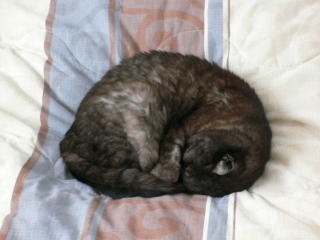Have you ever caught your cat sprawled out on its back, paws skyward, snoring away without a care in the world? It’s an adorable sight, but it’s also much more than just cute—it’s a powerful sign that your feline friend feels secure in your home. The way cats sleep isn’t random; it’s a window into their emotions, instincts, and the trust they place in their environment. For cat lovers, these subtle changes are like silent love letters from our furry companions, showing us that they feel truly at home. So, why do cats sleep so differently when they feel safe? Let’s explore the fascinating world of feline slumber and discover what those sleepy poses really mean.
The Origins of Feline Sleeping Habits

Cats are natural-born survivors, and their sleeping habits are deeply rooted in their wild ancestry. Long before they became our cuddly companions, cats roamed wild places where danger lurked around every corner. In the wild, cats had to be on constant alert for predators and other threats, which meant they developed ways to rest while staying ready to pounce or flee at a moment’s notice. Even today, these instincts are woven into the fabric of every domesticated cat. When a cat feels threatened, it tends to sleep in tight, protected positions—curled up, hidden, and always ready to spring into action. But as a cat learns that its home is truly safe, its sleep becomes deeper and its postures more relaxed. This transformation is nothing short of remarkable, revealing a world of trust and comfort that only a safe environment can provide.
Signs of a Safe and Secure Cat

One of the clearest signals that a cat feels safe is the way it stretches out to sleep. Instead of curling up tightly, a secure cat will often sprawl on its side or even on its back, exposing its vulnerable belly. This is a huge leap of faith for such a cautious animal. You might also notice your cat sleeping in open areas, rather than tucked away in hidden corners. Their breathing becomes slower and deeper, and their facial muscles relax. Sometimes, they’ll even let their limbs dangle off a couch or bed, adopting the famous “cat loaf” or “sploot” position. These behaviors are not random—they’re living proof that your cat has let its guard down and feels utterly safe in your presence.
Body Language: What Sleeping Positions Reveal

Feline body language during sleep is a fascinating study in trust. A cat that sleeps with its head resting on its paws, eyes half-closed, is often in a light doze, keeping watch just in case. When your cat curls into a ball, it’s trying to conserve warmth and protect vital organs, a throwback to its wild roots. However, when a cat lies flat on its side, with its legs stretched out or belly exposed, it’s a clear sign of deep relaxation and confidence. These positions leave the cat vulnerable, so they’re only adopted when your pet is absolutely sure there’s nothing to fear. Watching your cat sleep this way can tug at your heartstrings—it’s their way of saying they trust you completely.
The Role of Environment in Feline Sleep

A cat’s environment plays a huge role in how it sleeps. A noisy, chaotic, or unpredictable home will keep a cat on edge, making restful, open sleeping positions rare. In contrast, a peaceful and familiar space filled with positive experiences encourages cats to relax fully. Soft bedding, cozy nooks, and quiet corners all invite deep, restorative sleep. Cats are highly sensitive to changes in their surroundings, so even small adjustments—like moving furniture or introducing new pets—can disrupt their sleep. When a cat returns to its favorite sunny spot and dozes off without a care, it’s a living testament to the peace and security you’ve provided.
How Social Bonds Influence Cat Sleep

Cats may have a reputation for being independent, but the bonds they form with their humans are incredibly strong. When a cat feels emotionally attached and secure with its family, it will often choose to sleep near or even on its favorite people. You might find your cat curled up at your feet, on your pillow, or nestled in your lap. These moments are deeply meaningful—your cat is not just seeking warmth, but also expressing trust and affection. In multi-cat households, you’ll also notice that cats who get along well will often sleep in close proximity, sometimes even cuddling together. This behavior is a clear sign of social harmony and mutual security.
Deep Sleep and Dreaming: Signs of True Comfort

When cats feel truly safe, they slip into deep sleep cycles that allow for dreaming. During these periods, you might notice your cat twitching its whiskers, paddling its paws, or making tiny noises. These are signs of REM sleep, a state where the brain is highly active and where cats can dream just like humans do. Cats that don’t feel secure rarely reach this stage, instead remaining in lighter phases of sleep so they can wake up quickly if needed. Watching your cat dream is both endearing and reassuring—it means they feel safe enough to let their guard down completely, immersing themselves in the deepest, most restful sleep.
Changes in Sleeping Patterns and What They Mean

It’s important for cat owners to pay attention to changes in their pet’s sleeping habits. If a usually relaxed and sprawled-out cat suddenly starts sleeping in tighter, more hidden spots, it could be a sign that something is wrong. Stress, illness, or household changes can all disrupt a cat’s sense of security. On the other hand, a shy or nervous cat that begins to sleep in more open or vulnerable positions is showing signs of newfound trust and comfort. These changes in sleeping patterns are like little clues, helping you understand your cat’s feelings and well-being. Always observe your cat’s habits and consider what might be influencing their sense of safety at home.
Helping Your Cat Feel Even Safer

Every cat deserves to feel safe enough to sleep soundly, and there are plenty of ways you can help. Providing cozy beds in quiet places, keeping their routines consistent, and offering gentle affection all build a foundation of trust. Avoid sudden loud noises or chaotic changes in their environment, and give your cat a sense of control by allowing them to choose their favorite sleeping spots. Simple gestures, like speaking softly or blinking slowly, can also help reassure your cat. Over time, your cat’s sleeping habits will reflect the love and security you provide, rewarding you with those heartwarming, relaxed poses that every cat lover treasures.

Growing up traveling and experiencing new cultures and wonders, I have had a passion for nature, adventuring, photography, and videography. I am currently working towards a BSc in Biodiversity and Ecology at Stellenbosch University, and I hope to specialise in Marine Sciences one day.
Please send any feedback to Feedback@animalsaroundtheglobe.com






